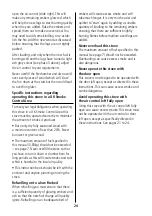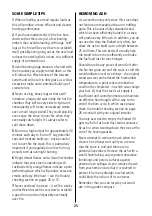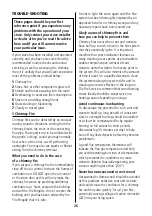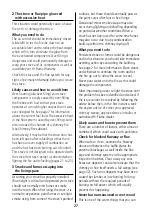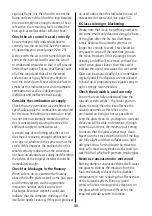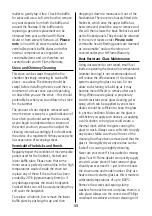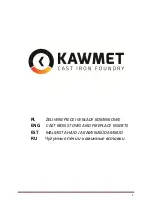
WHEN YOU FIRST LIGHT YOUR STOVE
Use smaller and shorter ‘gentle’ fires the first
five or six times, making these progressively
larger. This will help temper the steel and cast
iron components and avoid any potential
thermal shock which could damage them.
This process will also allow the paintwork to
cure. In fact, you may notice some wisps of
smoke or smell a hint of paint fumes coming
from the stove’s painted surfaces during these
early fires, however this is perfectly normal.
Your smoke alarm or CO detector may also
react to these. Simply ensure that the room
is well ventilated until this settles down. See
page 2 regarding this potential issue.
The hotter you burn the stove the more
intense these fumes will be, which is one
of the reasons that we advise that you use
smaller fires to start with. Every time the stove
reaches a new higher temperature it may still
be possible to detect fumes or smoke until
the paintwork is fully cured. If this persists or
gets any worse beyond the first few fires then
do not use the stove and immediately consult
your stove installer or stove dealer as this may
indicate a potential problem with the
installation. Again, see page 2.
Always allow the stove to fully cool down
between these first fires.
WHEN YOU LIGHT YOUR STOVE
AFTER STANDING IT DOWN
If the stove was correctly prepared for standing
down (see page 39) then simply confirm that
none of the components have deteriorated,
paying particular attention to the vermiculite
panels and baffle as these can be prone to
absorbing condensation. On Initial fires (say
three or four) you may again smell fumes which
will most likely be this condensation (or possibly
condensation within the chimney) simply
drying off. Unless it persists it is not usually
anything to be concerned about.
19
FUELS YOU MUST ALWAYS AVOID
This wood burning stove has been emissions
tested so that when correctly operated it will
have a minimum impact on local air quality
when only burning wood logs with a moisture
content of less than 20%. It has not been
tested for burning mineral fuels including
smokeless coal. Burning other fuels, apart from
logs, is an offence in a Smoke Control Area.
Burning the following materials could also
damage your stove and flue system, and will
render your Hi-Flame Warranty void.
• Never use your stove as an incinerator
Do not burn any household waste such as
magazines, newspapers, cardboard, milk cartons,
vegetable peelings, plastic and rubber etc.
• Never burn other types of wood
During combustion lacquered, painted or
tanalised wood, MDF, plywood, chipboard
and other manufactured wood could develop
substances which may be hazardous to your
health and also damage your stove and flue.
• Never burn petroleum coke
Never burn petroleum coke (aka pet coke) as
this burns at a very high temperature and its
continued use will almost certainly cause
irreparable damage to the stove components
such as the baffle plate and fire fence.
• Never burn bituminous house coal
This has a harmful effect on local air quality.
When burned it produces excessive smoke
and soot with the soot quickly building up
inside the stove’s flueway and flue which
increases the risk of dangerous blockages
and chimney fires. Smoky coal has now been
banned altogether in the Republic of Ireland.
• Never burn flammable liquids
Methylated spirits, petrol or other flammable
liquids should not be used to light the stove
as these could cause an explosion in the
confined spaces of the firechamber.




















